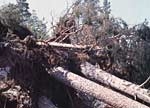 The last time that Sweden was stricken by a really bad storm was in 1969. It felled 35 million cubic meters of wood, which is less than half the volume damaged by the tornado last winter. Since then the quantity of timber and its volume, has increased by 55 per cent in the stricken area.
The last time that Sweden was stricken by a really bad storm was in 1969. It felled 35 million cubic meters of wood, which is less than half the volume damaged by the tornado last winter. Since then the quantity of timber and its volume, has increased by 55 per cent in the stricken area.Forest growth has increased by the same amount. The reason for this is a very successful forest management. Considerable efforts have been made to achieve durable and sustainable replanting and forest management. The proportion of different species of trees has not changed since the storm in 1969. All this time the forest has consisted of around 55 per cent spruce, 30 per cent pine and 15 per cent deciduous or broadleaved trees. If we pursue the present forest management policy line, the proportion of deciduous trees will increase strongly, while the proportion of spruce will remain at a stable level.
As a result of this year’s storm the stock of timber has decreased by about 17 per cent, which means that it is on the same level as in 1980. The proportion of spruce has decreased by 4 per cent, the proportion of deciduous trees has increased by 3 per cent and the proportion of pine by 1 per cent.
The storm is no reason to change the successful forest management policy in Southern Sweden. Also in the future spruce will be the ecologically most suitable and the most profitable species in most areas. In general birch constitutes the only alternative to spruce. Forestry research indicates that birch production in the stricken area reaches no more than 50 – 55 per cent of spruce production. For that reason birch as the main species is less attractive. The increasing natural mixture of deciduous trees that results from today’s sustainable forestry will nevertheless imply a greatly increased proportion of deciduous trees in the future.



